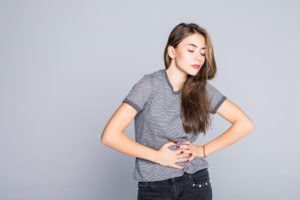Endometriosis

Endometriosis is a common reproductive condition that affects approximately, 1 in 10 women. It is characterised by tissue that acts like the lining of the uterus (the endometrium) being present in a variety of different locations throughout the body most commonly, the bladder, ovaries, fallopian tubes, ligaments that support the uterus and other areas within the abdomen and pelvis. Although rare, there have been cases of endometriosis being present within lung tissue!
It most commonly affects women of reproductive age however, symptoms of endometriosis can still be present even in menopause! It is estimated that 70% of women with chronic pelvic pain have endometriosis.
Clinically, many women present with dysmenorrhoea (painful periods) or menorrhagia (heavy periods) as well as dyspareunia (painful intercourse) without a complete diagnosis for their symptoms. The pain experienced can be so debilitating that they are unable to perform day-to-day tasks and are quite often bed ridden with a heat pack and painkillers quite often, only take the edge off, for some many women.
Other symptoms include premenstrual symptoms and extreme fatigue particularly premenstrually but the fatigue can also be chronic and many women are unable to shake it. Remember, Endometriosis is very much a condition associated with a lot of inflammation and inflammation is debilitating, let alone the pain that is associated with it.
Although endometriosis is a common reproductive disorder, there is not an exact cause for its development and this is why research is really being ramped up in this area. There are many contributing factors and these include:
- Oestrogen- too much oestrogen being produced or a sensitivity towards oestrogen
- Early onset puberty- this increases the body’s exposure to Oestrogen and thus can influence the development of endometriosis
- Retrograde flow- the use of tampons have been thought to push blood back into the uterus and pelvic cavity and increasing the risk of endometriosis developing however, this is now being looked at as a very simplistic way on analysing endometriosis
- Immune response- research is in its preliminary stages looking at the role the immune system has in influencing the growth of endometriosis. Viruses and pathogens have been linked to women with endometriosis.
- Excessive alcohol and caffeine use are known to increase inflammation and as a result are common risk factors with endometriosis
- There is also a link between direct family members and endometriosis. I.e. if a mother experienced endometriosis there is also a chance that her daughter will also develop it.
Quite often, endometriosis is diagnosed later in a women’s life and this is due to limitations in diagnosis. The only gold standard way of diagnosing endometriosis is through surgery, a laparoscopy. This is an invasive surgery however, if endometriosis is found, it can be excised (cut out) and this can assist with improving symptoms for 5 years.
Doctors may request for other diagnostic testing however, none are specific and they all have limitations to them.
There are 4 main stages of endometriosis:
- Stage 1- minimal deposits
- Stage 2- Mild and more deeper deposits
- Stage 3- Moderate deposits and deep implants with some cysts
- Stage 4- Severe and many deep implants and large cysts present
What is interesting is the stage of endometriosis doesn’t necessarily indicate the severity of symptoms. A women with stage 1 endometriosis may suffer debilitating pain throughout her menstrual cycle however, a women with stage 3 may have minimal symptoms.
As with diagnostic limitations, there is not a treatment for endometriosis. Surgery and certain medications can aid in improving quality of life, reduce pain, reduce the heaviness of periods and can also assist in improving fertility however, these options are not treatments for endometriosis.
As a Naturopath and a holistic Nutritionist, my role is to assist you in improving your quality of life. As a sufferer of Endometriosis myself, I am fully aware of the detrimental impacts this condition can have on ones life but I am also aware of the amazing role complementary medicine can also have.
What is important is assessing one’s lifestyle and diet. It is imperative that all endocrine disruptors are avoided and food is as anti-inflammatory as possible. In almost all instances, dietary plans are written to guide you with what to eat and what not to eat.
The joy of nutritional and herbal medicine is that many have been researched with positive results on reducing inflammation and the symptoms associated with Endometriosis. It is also important to look at your microbiome, the balance between the good and bad bacteria in your body as disruptions in this area could lead to a worsening of Endometriosis as a whole.
Assessing your immune system is also a crucial piece of the puzzle as Endometriosis in a way, acts a bit like an autoimmune condition.
All aspects of your health, diet and lifestyle as well as details related to your personal care products will be assessed, to see what can improve and what recommendations are suited to ensure you live your best life, with minimal impact from Endometriosis.
There isn’t one treatment plan that suits all, prescriptions and advice are based on your own individual circumstance and the severity of your symptoms, and that is the joy of holistic medicine! The positive is that gynaecologists, especially those who specialise in Endometriosis and advanced laparoscopic surgery are becoming more familiar with Naturopathic and holistic treatments, which means, it improves your health outcomes when we all can work together.
References:
- Agarwal, N., & Subramanian, A. (2010). Endometriosis – Morphology, Clinical Presentations and Molecular Pathology. Journal of Laboratory Physicians, 2(1), 1–9. http://doi.org/10.4103/0974-2727.66699
- American Society for Reproductive Medicine (1997). Revised American Society for Reproductive Medicine classification of endometriosis: 1996. Fertility and Sterility, 67(5), 817-821. Retrieved from http://www.fertstert.org/article/S0015-0282(97)81391-X/pdf
- Parasar P, Ozcan P, Terry K. Endometriosis: Epidemiology, diagnosis and clinical management. Curr Obstet Gynecol Rep. 2017. 6(1): 34-41

